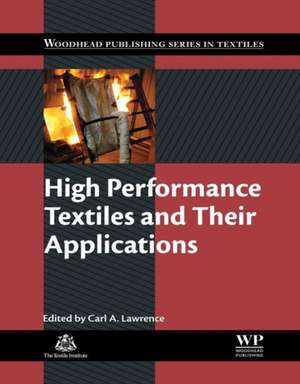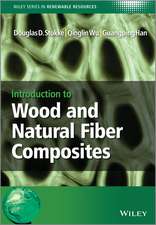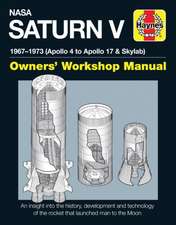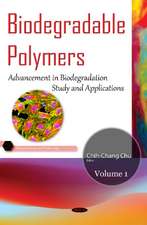High Performance Textiles and Their Applications: Woodhead Publishing Series in Textiles
Editat de C. Lawrenceen Limba Engleză Hardback – 4 iul 2014
- Reviews various approaches to modelling the geometry, structure and mechanical and physical properties of advanced textile materials
- Evaluates novel surface treatments involving plasma and laser technologies for a range of high performance textiles
- Focuses on textiles for specific purposes, with chapters devoted to textiles for heat and fire protection, wound care, industrial filtration, geotextiles, civil engineering and sustainable energy applications
Din seria Woodhead Publishing Series in Textiles
- 9%
 Preț: 947.93 lei
Preț: 947.93 lei - 9%
 Preț: 802.07 lei
Preț: 802.07 lei - 24%
 Preț: 802.53 lei
Preț: 802.53 lei - 9%
 Preț: 1158.65 lei
Preț: 1158.65 lei - 19%
 Preț: 340.02 lei
Preț: 340.02 lei - 24%
 Preț: 1133.92 lei
Preț: 1133.92 lei - 24%
 Preț: 1276.30 lei
Preț: 1276.30 lei - 24%
 Preț: 1132.28 lei
Preț: 1132.28 lei - 24%
 Preț: 949.23 lei
Preț: 949.23 lei - 24%
 Preț: 1162.55 lei
Preț: 1162.55 lei - 9%
 Preț: 1007.18 lei
Preț: 1007.18 lei - 24%
 Preț: 863.89 lei
Preț: 863.89 lei - 24%
 Preț: 1131.24 lei
Preț: 1131.24 lei - 9%
 Preț: 947.06 lei
Preț: 947.06 lei - 9%
 Preț: 1021.10 lei
Preț: 1021.10 lei - 9%
 Preț: 951.37 lei
Preț: 951.37 lei - 24%
 Preț: 1067.05 lei
Preț: 1067.05 lei - 24%
 Preț: 1511.33 lei
Preț: 1511.33 lei - 24%
 Preț: 1131.59 lei
Preț: 1131.59 lei - 9%
 Preț: 865.84 lei
Preț: 865.84 lei - 24%
 Preț: 1195.56 lei
Preț: 1195.56 lei - 24%
 Preț: 1027.26 lei
Preț: 1027.26 lei - 29%
 Preț: 845.48 lei
Preț: 845.48 lei - 24%
 Preț: 1232.53 lei
Preț: 1232.53 lei - 9%
 Preț: 1007.18 lei
Preț: 1007.18 lei - 20%
 Preț: 1125.16 lei
Preț: 1125.16 lei - 20%
 Preț: 1185.64 lei
Preț: 1185.64 lei - 9%
 Preț: 1272.93 lei
Preț: 1272.93 lei - 31%
 Preț: 1090.57 lei
Preț: 1090.57 lei - 9%
 Preț: 1156.05 lei
Preț: 1156.05 lei - 24%
 Preț: 1159.97 lei
Preț: 1159.97 lei - 5%
 Preț: 838.79 lei
Preț: 838.79 lei - 39%
 Preț: 803.30 lei
Preț: 803.30 lei - 9%
 Preț: 1092.20 lei
Preț: 1092.20 lei - 29%
 Preț: 1426.03 lei
Preț: 1426.03 lei - 23%
 Preț: 309.98 lei
Preț: 309.98 lei - 20%
 Preț: 883.71 lei
Preț: 883.71 lei - 24%
 Preț: 924.65 lei
Preț: 924.65 lei - 29%
 Preț: 1210.65 lei
Preț: 1210.65 lei - 5%
 Preț: 1001.89 lei
Preț: 1001.89 lei - 9%
 Preț: 726.56 lei
Preț: 726.56 lei - 31%
 Preț: 728.30 lei
Preț: 728.30 lei - 39%
 Preț: 899.39 lei
Preț: 899.39 lei - 9%
 Preț: 986.86 lei
Preț: 986.86 lei - 24%
 Preț: 988.42 lei
Preț: 988.42 lei - 9%
 Preț: 1045.16 lei
Preț: 1045.16 lei - 9%
 Preț: 1167.80 lei
Preț: 1167.80 lei
Preț: 911.09 lei
Preț vechi: 1190.83 lei
-23% Nou
Puncte Express: 1367
Preț estimativ în valută:
174.36€ • 181.36$ • 143.94£
174.36€ • 181.36$ • 143.94£
Carte tipărită la comandă
Livrare economică 07-21 aprilie
Preluare comenzi: 021 569.72.76
Specificații
ISBN-13: 9781845691806
ISBN-10: 1845691806
Pagini: 460
Ilustrații: illustrations
Dimensiuni: 156 x 234 x 31 mm
Greutate: 0.82 kg
Editura: ELSEVIER SCIENCE
Seria Woodhead Publishing Series in Textiles
ISBN-10: 1845691806
Pagini: 460
Ilustrații: illustrations
Dimensiuni: 156 x 234 x 31 mm
Greutate: 0.82 kg
Editura: ELSEVIER SCIENCE
Seria Woodhead Publishing Series in Textiles
Public țintă
This book is aimed at textile technologists, fibre scientists, textile engineers and textile researchers within academia.Cuprins
- Contributor contact details
- Woodhead Publishing Series in Textiles
- 1. Modelling structure–property relationships in advanced textile materials
- Abstract:
- 1.1 Introduction to textile modelling
- 1.2 Approaches to modelling geometry, structure, properties and processes
- 1.3 Experimental models
- 1.4 Modelling the geometry of fibre, yarn and fabric
- 1.5 Modelling the structure of textiles
- 1.6 Modelling the mechanical properties of textiles
- 1.7 Modelling the physical properties of textiles
- 1.8 Modelling textile processes: continuous models
- 1.9 Modelling textile processes: discrete models
- 1.10 Optimization of performance characteristics: linear and non-linear methods
- 1.11 Sources of further information and advice
- 1.12 References
- 2. Novel surface treatments for high performance textiles
- Abstract:
- 2.1 Introduction
- 2.2 Plasma technologies for textiles
- 2.3 Plasma treatments for high performance textiles
- 2.4 Laser technologies for textiles
- 2.5 Comparing plasma and laser treatments of textile surfaces
- 2.6 Conclusions
- 2.7 References
- 3. High performance textiles for protective clothing
- Abstract:
- 3.1 Introduction
- 3.2 Requirements for protective clothing
- 3.3 High performance textile fibres
- 3.4 Conventional and high performance fibre blends for protective clothing
- 3.5 Cut resistant and energy absorption materials
- 3.6 Clothing for firefighters
- 3.7 Chemical protective clothing (CPC)
- 3.8 Materials to improve thermo-physiological comfort of protective clothing
- 3.9 References
- 4. High performance textiles for heat and fire protection
- Abstract:
- 4.1 Introduction
- 4.2 Principles of textile heat and fire protection
- 4.3 Routes to achieving fire and heat protection
- 4.4 Evolving technologies and future trends for heat and fire protection
- 4.5 Applications of heat protective textiles
- 4.6 Sources of further information and advice
- 4.7 References
- 5. High performance medical textiles: an overview
- Abstract:
- 5.1 Introduction
- 5.2 Textiles for hygiene and infection control
- 5.3 High performance implantable textiles
- 5.4 Textiles for tissue engineering applications
- 5.5 Textiles for healthcare monitoring
- 5.6 Future trends
- 5.7 References
- 6. High performance textiles for wound care
- Abstract:
- 6.1 Introduction
- 6.2 Wounds and wound management
- 6.3 Wound dressings
- 6.4 Hi-tech wound dressings: non-adherent, odour adsorbent, activated charcoal cloth (ACC), and antimicrobial dressings
- 6.5 Treatment of venous leg ulcers
- 6.6 Venous leg ulcer treatment using compression bandages
- 6.7 Improving compression bandages: non-woven vari-stretch compression bandages (NVCB) and three-dimensional compression bandages
- 6.8 Conclusions
- 6.9 References
- 7. High performance textiles for industrial filtration
- Abstract:
- 7.1 Introduction
- 7.2 Dust collection
- 7.3 Fibre selection for dust collection
- 7.4 Fabric types for dust collection
- 7.5 Fabric finishing techniques
- 7.6 Solid–liquid filtration
- 7.7 Filtration equipment
- 7.8 Fabric selection for solid–liquid filtration
- 7.9 Fabric constructions and yarn types for solid–liquid filtration
- 7.10 Fabric finishing techniques
- 7.11 Future trends
- 7.12 Sources of further information and advice
- 7.13 References
- 8. High performance textiles for geotechnical engineering: geotextiles and related materials
- Abstract:
- 8.1 Introduction
- 8.2 Classification of geosynthetics
- 8.3 Functions of geosynthetics: filtration
- 8.4 Functions of geosynthetics: drainage
- 8.5 Functions of geosynthetics: separation
- 8.6 Functions of geosynthetics: reinforcement
- 8.7 Functions of geosynthetics: containment (fluid barrier) and protection
- 8.8 Index and performance testing of geotextiles
- 8.9 Geotextile materials: polymers and fibres
- 8.10 Geotextile materials: non-woven geotextiles
- 8.11 Geotextile materials: woven and warp knitted
- 8.12 Geogrids, geonets and geomembranes
- 8.13 Geocomposites
- 8.14 Factors affecting the separation and filtration mechanism of geotextiles
- 8.15 Factors affecting the drainage mechanism of geotextiles
- 8.16 Factors affecting the protection mechanism of geotextiles
- 8.17 Factors affecting the reinforcement mechanism of geotextiles
- 8.18 Applications: road construction
- 8.19 Applications: rail track construction
- 8.20 Applications: tunnel construction
- 8.21 Applications: reinforced soil structures
- 8.22 Applications: fluid containment systems
- 8.23 Applications: erosion control
- 8.24 Future trends
- 8.25 References
- 9. High performance fibers and fabrics for civil engineering applications
- Abstract:
- 9.1 Introduction
- 9.2 Fibers
- 9.3 Fabrics
- 9.4 Composites
- 9.5 Future trends
- 9.6 Sources of further information and advice
- 9.7 References
- 10. High performance fibre-reinforced composites for sustainable energy applications
- Abstract:
- 10.1 Introduction: current use of composite materials in sustainable energy technology
- 10.2 The use of nanoparticles in composites
- 10.3 In-service requirements of advanced fibre-reinforced polymer (FRP) composites for sustainable energy applications
- 10.4 Manufacture of FRP composite materials for sustainable energy technologies
- 10.5 Composite materials/fabrication techniques for on-shore and off-shore wind turbines
- 10.6 Composite materials/fabrication techniques for tidal energy power generators
- 10.7 Composite materials/fabrication techniques for solar energy applications
- 10.8 Conclusions and future trends
- 10.10 Acknowledgements
- 10.9 Sources of further information and advice
- 10.11 References
- 10.12 Appendix: solar power
- Index
Recenzii
"...brings together contributions from an international team of authors from both academia and industry. It will be an essential reference work for textile technologists, scientists and researchers." --Asian Technical Textiles, 2014













